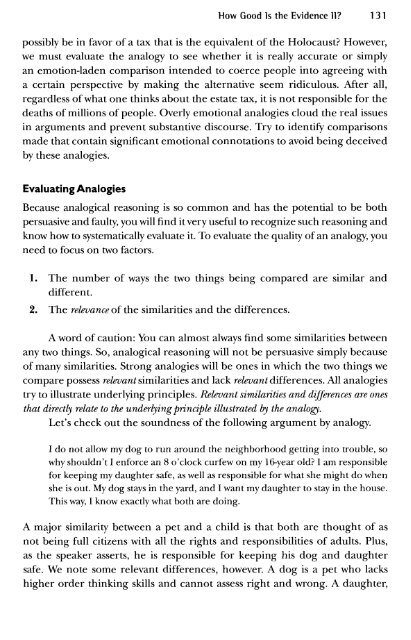Asking the Right Questions, A Guide to Critical Thinking, 8th Ed
Asking the Right Questions, A Guide to Critical Thinking, 8th Ed
Asking the Right Questions, A Guide to Critical Thinking, 8th Ed
You also want an ePaper? Increase the reach of your titles
YUMPU automatically turns print PDFs into web optimized ePapers that Google loves.
How Good Is <strong>the</strong> Evidence 11? 131<br />
possibly be in favor of a tax that is <strong>the</strong> equivalent of <strong>the</strong> Holocaust? However,<br />
we must evaluate <strong>the</strong> analogy <strong>to</strong> see whe<strong>the</strong>r it is really accurate or simply<br />
an emotion-laden comparison intended <strong>to</strong> coerce people in<strong>to</strong> agreeing with<br />
a certain perspective by making <strong>the</strong> alternative seem ridiculous. After all,<br />
regardless of what one thinks about <strong>the</strong> estate tax, it is not responsible for <strong>the</strong><br />
deaths of millions of people. Overly emotional analogies cloud <strong>the</strong> real issues<br />
in arguments and prevent substantive discourse. Try <strong>to</strong> identify comparisons<br />
made that contain significant emotional connotations <strong>to</strong> avoid being deceived<br />
by <strong>the</strong>se analogies.<br />
Evaluating Analogies<br />
Because analogical reasoning is so common and has <strong>the</strong> potential <strong>to</strong> be both<br />
persuasive and faulty, you will find it very useful <strong>to</strong> recognize such reasoning and<br />
know how <strong>to</strong> systematically evaluate it. To evaluate <strong>the</strong> quality of an analogy, you<br />
need <strong>to</strong> focus on two fac<strong>to</strong>rs.<br />
1. The number of ways <strong>the</strong> two things being compared are similar and<br />
different.<br />
2. The relevance of <strong>the</strong> similarities and <strong>the</strong> differences.<br />
A word of caution: You can almost always find some similarities between<br />
any two things. So, analogical reasoning will not be persuasive simply because<br />
of many similarities. Strong analogies will be ones in which <strong>the</strong> two things we<br />
compare possess relevant similarities and lack relevant differences. All analogies<br />
try <strong>to</strong> illustrate underlying principles. Relevant similarities and differences are ones<br />
that directly relate <strong>to</strong> <strong>the</strong> underlying principle illustrated by <strong>the</strong> analogy.<br />
Let's check out <strong>the</strong> soundness of <strong>the</strong> following argument by analogy.<br />
I do not allow my dog <strong>to</strong> run around <strong>the</strong> neighborhood getting in<strong>to</strong> trouble, so<br />
why shouldn't I enforce an 8 o'clock curfew on my 16-year old? I am responsible<br />
for keeping my daughter safe, as well as responsible for what she might do when<br />
she is out. My dog stays in <strong>the</strong> yard, and I want my daughter <strong>to</strong> stay in <strong>the</strong> house.<br />
This way, I know exactly what both are doing.<br />
A major similarity between a pet and a child is that both are thought of as<br />
not being full citizens with all <strong>the</strong> rights and responsibilities of adults. Plus,<br />
as <strong>the</strong> speaker asserts, he is responsible for keeping his dog and daughter<br />
safe. We note some relevant differences, however. A dog is a pet who lacks<br />
higher order thinking skills and cannot assess right and wrong. A daughter,



